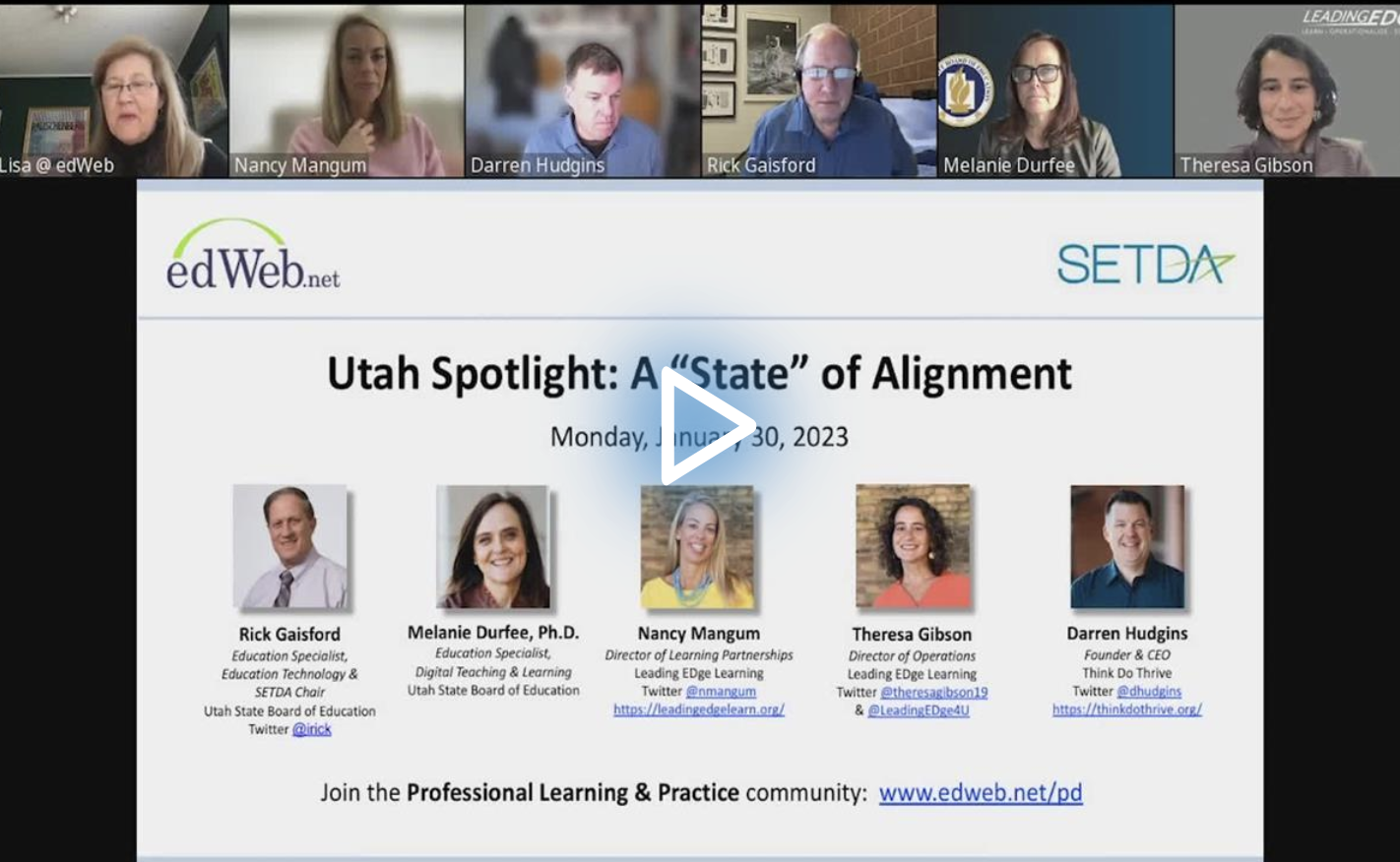The Importance of the Right Technology in Schools
Watch the Recording Listen to the Podcast
A recent edLeader Panel, “Utah Spotlight: A ‘State’ of Alignment,” featured experts that included Rick Gaisford, Education Specialist, Education Technology and the SETDA Chair Elect, Utah State Board of Education; Melanie Durfee, Ph.D., Education Specialist, Digital Teaching & Learning, Utah State Board of Education; Nancy Mangum, Director of Learning Partnerships, Leading EDge Learning; Theresa Gibson, Director of Operations, Leading EDge Learning; and Darren Hudgins, Founder and CEO, Think Do Thrive.
Gaisford spoke about the State Educational Technology Directors Association and the EdTech Trends Report, which was created to track the impact of technology on education across the country.
Mangum then took the floor to take the attendees back to 2016 and talked about the important edtech trends of that time. She mentioned that blended learning and learning models were the top edtech trends, and defining blended learning was a big deal. Infrastructure and connectivity were also important, and the country was trying to find ways to connect schools and make sure that there were enough access points for all students.
The edLeader Panel provided a great platform for edtech experts to come together and discuss the latest trends and innovations in the field. It was an opportunity for attendees to learn from the experts and get a better understanding of the state of education technology.
The panelists discussed a program in Utah aimed at improving the education system through the use of technology. The program was based on a framework that emphasized providing a systematic support system for students, engaging them in the learning process, and developing STEM career paths. The program had three foundational components: access to technology, professional learning for teachers, and technical support.
The Utah legislature asked the creators of the program to put together a master plan, which became the guiding document for the program. The program was funded through digital teaching and learning (DTL) grants, which were designed as a qualifying grant program. To qualify for the grants, districts had to establish a goal for the program that was tied to their local strategic plans, such as increasing test scores or focusing on an area of the curriculum where they were showing weakness. The goal of the program was to provide high-quality instruction in every classroom and technology was seen as the vehicle to make that happen.
Utah has taken a comprehensive and collaborative approach to education reform, and this is evident in the development of its Portrait of a Graduate framework. Over 100 educators from different levels, including preschool teachers and higher ed administrators, participated in work groups that helped define the competencies that students should have when they graduate from high school.
The state board of education and its partners have taken a new approach to leadership and learning, ensuring that everyone has a shared vision and understanding of what is expected. They have created internal professional learning sessions and have provided learning opportunities for leaders at different levels, including district, school, tech, and instructional coaches. Additionally, they have created networks for teacher professional learning that allow educators to collaborate across districts and share best practices. The Utah experience highlights the importance of aligning all stakeholders, including teachers, administrators, and policymakers, in order to create a comprehensive and effective education system.
The implementation of technology in schools has been a rapidly growing trend for the past 30 years. While many educational technologies have come and gone, the right technology, when it fits properly, can provide significant benefits to teaching and learning. To ensure that technology is used effectively in education, it must be a good fit for the students and allow them to bring their knowledge, skills, background, and creativity to the table.
The Key to Success: A Vision and Iteration
Having a vision and iterating it is key to the successful integration of technology in education. Many states have visions for technology in education, but often they jump from one vision to the next without making sure they all fit together.
In Utah, the state has been successful in connecting and aligning these visions, making sure they all fit together and are not driven by fear. To make sure technology is used effectively, a feedback loop is critical. This way, teachers’ voices are heard by building administrators, district leaders, and state leaders.
The Influence of Common Core and SBAC Testing
Utah participated in the Common Core standards and was an SBAC state for online testing. This was a big factor in the state’s push for technology in education. The need for online testing led to the conversation about making sure every student had access to technology. The testing was the starting point, but it quickly became apparent that providing every student with a device would also be important.
The Portrait of a Graduate: The Center of All Decisions
In Utah, the Portrait of a Graduate has become the center of all decisions. This is the “why” behind edtech and why it is being implemented. The Portrait of a Graduate outlines the competencies that edtech can help students achieve, making it the perfect reason for technology in education.
In conclusion, technology in education can provide tremendous benefits when done correctly. The key to success is having a vision and iterating it, making sure all components fit together and are driven by a clear reason or purpose. In Utah, the Portrait of a Graduate serves as the “why” for edtech, making it the center of all decisions.
Learn more about this edWeb broadcast, “Utah Spotlight: A ‘State’ of Alignment,” sponsored by SETDA.
Watch the Recording Listen to the Podcast
Join the Community
Professional Learning & Practice is a free professional learning community that presents edWebinars and hosts online discussion forums on a wide range of issues on professional learning and educator practice.






Comments are closed.